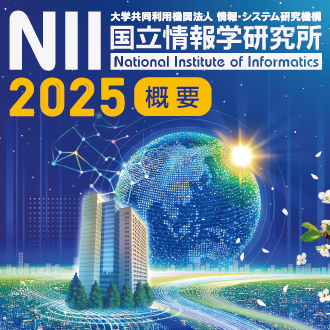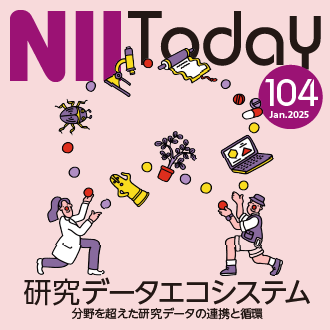イベント / EVENT
デモ・ポスター展示 2020
デモ・ポスター展示
NIIオープンハウス 2020 特設サイト:ポスターセッション
[A] アーキテクチャ・ソフトウェア/うごかすちから(A1-A10)
A1: データ収集・蓄積・解析クラウド基盤
ネットワークとクラウドを活用してデータ収集から解析まで - IoT、ビッグデータ、教育基盤
クラウド基盤研究開発センター
データ収集から解析までを行う分散アプリケーション基盤を構築するシステム を紹介します。SINETStream を利用することで、広域ネットワーク上の IoTデ バイスのセンサーデータの収集・解析を行うアプリケーションの構築ができる ようになります。また Virtual Cloud Provider を利用することで、複数のク ラウド環境を活用して、ゲノム解析等の研究環境やCMS等の教育環境の構築が できるようになります。さらに、データ解析時のメモリ使用量などの実行時特 性を収集し、資源選択や可視化等への活用を行う監視・分析システムも紹介し ます。
A02:双方向変換の活用 | Application of bidirectional transformation
双方向化技術によるデータベーススキーマの共存 | (Co-existing Database Schemas based on Bidirectional Transformation)
田中順平 (Jumpei Tanaka)
様々な情報システムにおいて、その進化に伴い、データベースは元のスキーマから新しいスキーマへと多方面に発展していきます。しかしデータ構造の違うスキーマ間で更新を互いに反映させ合うことが難しく、それらのスキーマを共存させることは困難な課題となっています。本研究では、双方向変換を応用し、この課題を解決する手法を提案します。
Along with evolution of information systems, database evolves form the original schemas to various new schemas. Co-existing schemas is a challenging problem because of update propagation among different data structure of schemas. This research proposes a new methodology to solve it by applying bidirectional transformation.
A03:社会人向け教育
サイエンスによる知的ものづくり教育プログラムトップエスイー
トップエスイープロジェクト
2019年度の活動実績、活動成果例
A04:クラウド | Cloud
CoursewareHub: プログラミング講義向けJupyter Notebook環境
CoursewareHub: A classroom tool for programming lessons based on Jupyter Notebooks
先端ICTセンター/クラウド基盤研究開発センター
Advanced ICT Center / Center for Cloud Research and Development
NIIでは講義のためのJupyter Notebook環境として「CoursewareHub」を開発、運用しています。CoursewareHubはオープンソースコミュニティで開発されているJupyterHubに対して講義向けの支援機能を加えたソフトウェアで、プログラミング講義における効率的な講義資料配信や授業進行の分析機能を提供します。また本環境は、Jupyter Notebookを使った運用テクニックにより、効率的な環境構築・運用を行うことが可能です。本展示では、昨年度の複数の大学の講義でのCoursewareHubの利用事例と、実際の利用画面、分析画面などをご紹介します。
CoursewareHub is an NII's enhancement of JupyterHub. Our extensions help teachers to manage and deliver lecture materials and to analyze the progress activity of students. CoursewareHub is customizable and easily deployable via Jupyter Notebook, which is a live document describing operation and installation procedures. We present use-cases from some university practices including actual classroom materials and activity analytics.
A05:クラウド | Cloud
Notebookで賢く運用!NIIの研究クラウド
Notebook makes NII cloud operation smart!
先端ICTセンター/クラウド基盤研究開発センター
Advanced ICT Center / Center for Cloud Research and Development
NIIでは所内向けの研究リソースとして OpenStack を用いたプライベートなベアメタルクラウドを運用しています。その3世代目となる Academic Beametal Cloud は、SINETによる柔軟な拠点間VPNへの対応や、利用者毎のリソースを厳格に分離した環境を提供しています。また、LC4RIと呼ぶ、 Jupyter Notebook を用いた構築・運用手法を実践しており、小規模な運用チームでのサービス提供を実現しています。本展示では、 Academic Baremetal Cloudの運用に用いているJupyter Notebook環境「OperationHub」をご紹介します。
As a service for researchers, NII has been operating private bare-metal OpenStack. Their 3rd generation Academic Baremetal Cloud accommodates SINET VPN natively and isolates customer's resources rigorously. On top of that, we conduct infrastructure utilizing Jupyter Notebook. The practice, what we call LC4RI, augments the capability of a small engineering team. We present "OperationHub," which is an extended and integrated Jupyter Notebook environment for operational engineers.
A06:やわらかいハードウェアの可能性を探る | Challenges to "soft" hardware
再構成可能デバイスを使いやすくする研究
Reconfigurable devices for globally asynchronous / locally synchronous systems
米田友洋
Tomohiro Yoneda
再構成可能デバイスとして、FPGA(Field Programmable Gate Array)の利用が広まっていますが、実際に大きな回路を実装しようとするとクロック分配にまつわる様々なタイミング制約問題が生じ、設計を難しくしています。そこで、グローバルクロックを使わない非同期式回路技術を組み合わせることで、大規模FPGAの設計を容易化する研究を進めています。
Recently, FPGAs (Field Programmable Gate Array) are used in various fields and applications. It is, however, not so easy to implement large designs on FPGAs due to complicated timing constraints needed for global clock distribution. This research focuses on an ""asynchronous"" (or global-clock-less) reconfigurable mechanism to connect smaller synchronous blocks, which can potentially avoid such global clock distribution problems of large designs.
A07:安全性と柔軟性を両立するプログラミング言語
漸進的型付け: 安全性と柔軟性を両立するプログラミング言語
関山 太朗
ソフトウェアを記述するプログラミング言語の多くには、その安全性を保証するための仕組みとして型システムと呼ばれる機構が組み込まれている。型システムは、網羅的に誤りを検出できる静的型システムと、網羅的な誤り検出はできないがより柔軟にプログラミングが行える動的型システムに大別することできる。本ポスターでは静的型システムの安全性と動的型システムの柔軟性を両立する、漸進的型システムについて紹介する。
A08:Automatically Finding Bug Locations | 自動的にバグの場所を見つける
Program Spectra Visualization and Analysis for Fault Localization | 不具合局所化のためのプログラムスペクトルの可視化ならびに分析
ERATO蓮尾メタ数理システムデザインプロジェクト
ERATO Hasuo Metamathematics Systems Design Project
Spectrum-Based Fault Localization (SBFL) is a well-known approach to identify the faults of the subjective program based on the information derived from testing. However, because of the diversity of real-life programs and faults, current SBFL techniques cannot adapt all the debugging situations. Without knowing how SBFL works, we cannot get sufficient confidence to use it in practice. In our work, we propose a framework that can illustrate the spectra distributions of various debugging instances and the performance of SBFL at these instances in a graphical way. Based on visualization, we analyze the spectra distribution of various instances and the rationale of applying SBFL techniques on these instances. In this way, we can get more guidance about the practical application of SBFL. Particularly, we use our framework to visualize the accident spectra of an automotive vehicle model and analyze the possibility of adapting SBFL to automotive driving systems.
スペクトルに基づく不具合局所化(Spectrum-Based Fault Localization, SBFL) は、テストから得られた情報に基づいて,プログラム文の発生したバグの原因箇所を推定する方法である。しかし、現実のプログラムならびにバグの多様性のため、現在のSBFL技術ではすべての状況に適応できない。SBFLがどのように機能するかを知らずして,確信をもって実応用において実際に利用することはできない。本研究では,様々なデバッグインスタンスのスペクトル分布と,それらについてSBFLの性能をグラフィカルな方法で示すフレームワークを提案する。可視化に基づいて,様々な事例におけるスペクトルの分布、ならびにこれらの事例に対してSBFL手法の合理性を分析する。これにより、SBFLの適用性に関わるガイダンスを得ることができる。特に、このフレームワークを用いて、自動車モデルの事故スペクトルを可視化し、SBFLを自動運転システムに適応させる可能性を分析する。
A09:Testing of autonomous driving systems | 自動運転システムのテスト
Search-Based Testing and Automatic Reconfiguration of a Path Planner | 経路計画機能のテスト・設定調整の自動探索
ERATO MMSD - Formal Methods and Intelligence | ERATO MMSD - インテリジェンス協働形式手法グループ
The oracle problem is a key issue in testing Autonomous Driving Systems (ADS): when a collision is found, it is not always clear whether the ADS is responsible for it. We propose a search-based testing (SBT) approach for solving this problem by defining a collision as avoidable if a differently configured ADS would have avoided it. The approach searches for both collision scenarios and the ADS configurations capable of avoiding them.
The approach has been experimented on the path planner component of an ADS provided by our industry partner. Results show that different types of collisions require different configurations to be avoided. Based on these results, we propose to re-engineer the path planner as a "self-adaptive path planner" that, at runtime, is able to reconfigure itself with the configuration that is most suitable for the current driving scenario.
自動運転システムをテストする際には、「テストが成功したか・失敗したか」の判断基準(オラクルと呼ぶ)が重要な課題である。なぜなら、衝突が起きるような状況を見つけたとしても、それは必ずしも自動運転システムの責任とは限らないからである。我々はこの問題に対し、「少し設定が違う自動運転システムなら避けられる」ということをもって、「避けられる(避けるべき)衝突」と定義したテスト手法を提案している.この手法では,衝突が発生するシナリオとともに,その衝突を避けるよう自動運転システムの設定調整を行う方法も検出する。提案手法を用い、産業界から提供された経路探索ソフトウェアに対する実験を行った結果、異なる種類の衝突に対しては,異なる設定調整が必要であることがわかった.我々はこの知見からさらに,現状の運転シナリオに対して最も適した設定を実行時に行うことが可能であるような自己適応型経路計画ソフトウェアも構築した。
A10:ソフトウェアの要件の「ぼかし方」に関する研究 | Research on refinement-based formal specifications
適切な「ぼかし」で、ソフトウェアの複雑さに挑む
Dealing with complexity of software with abstraction
小林 努
Tsutomu Kobayashi
ソフトウェアシステムの信頼性を保証するためには、求められる要件を明確化し、それらが満たされることを確認する必要があります。
特に近年複雑化するソフトウェアでは信頼性が重要である一方、検証が難しくもあります。
我々は、全体の正しさを保ったまま適切な「ぼかし」方をして要件を解きほぐしつつソフトウェアの性質について厳密に議論するアプローチについて研究しています。
本発表では、ぼかし方に対してリファクタリングや解析などの工学的アプローチを適用する研究や、ぼかしを上手に用いて自動運転のソフトウェアを検証する試みについて説明します。
In order to ensure the dependability of software systems, it is essential to clarify the requirements and verify they are satisfied.
Recent complex systems, especially, requires careful consideration of requirements but makes verification more difficult to handle.
We tackle this problem based on an approach called `stepwise refinement', namely starting from verifying abstract requirements and gradually making them complex and realistic.
This presentation introduces our studies on the refactoring and analysis on refinement-based formal specifications.
We also present applications of such techniques to advanced systems such as software for autonomous vehicles.
[B] 数理・論理・量子情報/考え方をかんがえる (B1-B7)
B01:理論計算機科学入門 | Introduction to Theoretical Computer Science
理論計算機科学入門: 有限と無限のあいだ ~ オートマトン理論を例に
Introduction to Theoretical Computer Science: Interplay between Finite and Infinite
システム設計数理国際研究センター
Global Research Center for Systems Design and Mathematics
計算機やプログラムの振る舞いについて、数学を使って研究するのが理論計算機科学という分野です。応用数学の一分野として見た場合、その大きな特徴は「有限と無限のせめぎあい」です。計算機やプログラムといった「機械」や「レシピ」は無限に豊かな振る舞いを持つ一方で、これらを実際に作ったり記述するためには、そのサイズは有限でなければなりません。この「有限と無限のせめぎあい」という一大テーマについて、オートマトン理論を通してお話しします。
One big theme in an academic field called theoretical computer science is the interplay beteen finite and infinite. This theme is discussed in an elementary and accessibility manner, using the language inclusion problem in automata theory as a concrete example.
B02:量子コンピュータ・量子シミュレーション | Quantum computer and quantum simulation
量子の世界に潜むスケールフリーネットワーク
Scale-free networks hidden in the quantum world
根本香絵
ミクロの世界へズームインすると、物質は量子力学的に振舞うことが知られています。物質の中の状態は、様々な要素が絡み合うため、その量子力学的な振舞いを見極め、理解することはなかなか難しいものです。そこで、私たちがより正確に、また個別に操作することのできる物理系を使って、物質の中での物理を解明する試みは量子シミュレーションと呼ばれます。私たちは、量子シミレーションに使われる物理系を用いて、その中に潜むスケールフリーネットワークを初めて捉えることに成功しました。本ポスターではその研究成果をご紹介します。
When we zoom into a microscopic scale, we start to observe quantum mechanical effects arising in such materials. In a real material there are so many atoms interacting each other that it is typically too complicated to analyse in detail. One way to investigate these complex systems is via a quantum simulation where we aim to realize the behaviour of our physical system of interest in another much more controllable system. Using our capability to control such quantum systems in the simulator, we have discovered scale-free network behaviour hidden at the quantum level. This property is universal in many different physical systems and can be used to simulate classical network behaviour with an exponential compression.
B03:計算量理論、暗号 | Computational Complexity Theory, Cryptography
計算量理論と暗号の安全性
Computational Complexity Theory and the Security of Cryptography
平原秀一
通信の秘密を守るために暗号技術は広く用いられていますが、実は本当に安全かどうかわかっていません。本ポスターでは100万ドルの懸賞金が懸けられている「P≠NP予想」と暗号の安全性に関して概観を与えます。
Cryptographic technologies are widely used in order to protect the security of our daily communications. However, these are not proved to be secure yet. In this poster, we provide an overview of the relationship between cryptography and ""the P versus NP problem"", which is one of the millennium prize problems.
B04:Numerical linear algebra
Inner-iteration preconditioned block GMRES
Zeyu Liao
consider using block GMRES to solve the least squares problems with multiple right-hand sides. This generates the Krylov subspace and updates the QR decomposition for the Hessenburg matrix block-wise. Block GMRES requires a larger Krylov subspace to converge. Hence, we propose combining block GMRES with block-wise inner iteration preconditioning and avoid restarting. Numerical experiments show that the proposed method is efficient.
B05:多様な価値観の比較 | A comparison of diverse values
ネットワークにおける頂点の重要度の感度解析
Sensitivity Analysis of Network Centralities
吉田悠一
Yuichi Yoshida
重要な頂点を明らかにすることは、ネットワーク分析の基本的な作業である。そのために多くの指標が提案されており、総称して「中心性」と呼ぶ。しかしあまりに多くの中心性が研究されており、その違いが不明瞭になっている。そこで本研究では、グラフの変化に対する感度に基づいて中心性を比較する。具体的には、近接中心性、調和中心性、媒介中心性、終点媒介中心性、PageRank、全域木中心性の6つの主要な中心性について感度の理論的な分析を行った。人工グラフと実グラフを用いた実験により、理論解析で予測された傾向を確認した。
Revealing important vertices is a fundamental task in network analysis. As such, many indicators have been proposed for doing so, which are collectively called centralities. However, the abundance of studies on centralities blurs their differences. In this work, we compare centralities based on their sensivitity to modifications in the graph. We conducted a theoretical analysis of the edge sensitivities of six major centralities: the closeness centrality, harmonic centrality, betweenness centrality, endpoint betweenness centrality, PageRank, and spanning tree centrality. Our experimental results on synthetic and real graphs confirm the tendency predicted by the theoretical analysis.
B06:口コミ効果の最大化 | Maximization of word-of-moutn effects
口コミ効果の最大化:やってみよう!ゲーム Infomania
Let's play"Infomania"! and learn Maximization of word-of-moutn effects!
ビッグデータ数理国際研究センター
Global Research Center for Big Data Mathematics
センター長 河原林 健一
Research Director Ken-ichi Kawarabayashi
人のつながりを介した口コミ効果は, 劣モジュラ関数と呼ばれる数学の概念 で表されます。これを利用して、我々は口コミを効果的に広げるためのアルゴリズムの研究に取り組んでいます。
The word-of-mouth effect through human connections can be explained by a mathematical concept "submodular function". We are working on developing algorithms to spread word-of-mouth effectively in maximizing submodular functions.
B07:Time series | 時系列
Formalisation of Time Series Representation for Food Prices
食品価格の時系列表現の形式化
Ignacio Truffat
イグナチオ ツルファ
Time Series and their manipulation are part of a vast area of research, with a lot of challenging state-of-the-arts solutions and innovative ideas. In this poster, we will explain the originality and the basic concepts behind the Algebra we are currently developing in the TimeSheep Project, as well as putting out what kind of problems could be represented and the solutions we could proposed.
時系列とその操作は、研究の広大な領域の一部であり、多くの難易度の高い最先端のソリューションと革新的なアイデアを備えています。このポスターでは、TimeSheepプロジェクトで現在開発中の代数の背後にある独創性と基本的な概念を説明するとともに、どのような問題が生まれ、また、提案できる解決策についても説明します。
B08:情報と物理の融合を数学で目指します | Fusion of Information and Physical Systems via Mathematics
数学からソフトウェア、そしてものづくりへ
From Mathematics to Software Development and Manufacturing
ERATO蓮尾メタ数理システムデザインプロジェクト
ERATO Hasuo Metamathematics Systems Design Project
ERATO蓮尾プロジェクトでは、安全なソフトウェアの数学的開発手法を物理情報システムに拡張することで、安全で高信頼なIT社会の建設に貢献します。
ERATO Hasuo project aims to help the construction of safe and reliable IT society by extending mathematical development methods of safe software systems to cyber-physical systmes.
[C] 人工知能/計算機に思考させる (C1-C9)
C1: ITによる新しい医療支援 | Innovative aids for medicine through IT
医療ビッグデータクラウド基盤構築とAI画像解析研究
Study on cloud platform and AI image analysis for medical bigdata
医療ビッグデータ研究センター
Research Center for Medical Bigdata
平成29(2017)年11月に新設された医療ビッグデータ研究センターでは、医療ビッグデータクラウド基盤を構築することと、AIなどの機械学習を利用した画像解析の研究に取り組んでいます。当センターにおけるこの2年半の取り組みの現状と、今後の展望について紹介します。
Founded in November 2017, Research Center for Medical Bigdata (RCMB) has been working on construction of cloud platform for medical bigdata and studies for medical image analysis using machine learning including artificial intelligence (AI). Here we are going to introduce our last two-and-half years activities and what the future might hold for the bigdata and AI.
C2: 人工知能 | Artificial Intelligence
知識表現・推論と機械学習を統合したロバストAI
Robust AI: Integrating KR&R and ML
井上 克巳、リシュー フロリアン、岡崎 孝太郎、ロルティワル ギヨム、ポア インジュン、グエン テュアン、竹村 彰浩、小高 充弘、戸塚 悠太郎、陳 天宇、徐 哲恒、ライモン シリル、佐藤 泰介、坂間 千秋、沖本 天太、シュウィンド ニコラ、マニアン モルガン、リベロ トニー>
Katsumi Inoue, Florian Richoux, Kotaro Okazaki, Guillaume Lorthioir, Yin Jun Phua, Tuan Nguyen Quoc, Akihiro Takemura, Mitsuhiro Odaka, Yuutaro Totsuka, Tianyu Chen, Zhenheng Xu, Cyril Reymond, Taisuke Sato, Chiaki Sakama, Tenda Okimoto, Nicolas Schwind, Morgan Magnin, Tony Ribeiro
AIを信頼可能なものとするためには,説明可能性に加えて,ロバスト性,すなわち,予め想定されていない状況に置かれても機能を失うことなく柔軟に対応できる性質を持つ必要がある.現在AIを応用したシステムの多くは,機械学習技術の進歩によって強化されたパターン認識機能をベースにしている. 一方でAI研究においては,知識表現・推論について盛んに研究されてきており,診断,計画,設計,意思決定を含む高度な知的作業において活用されてきた.これまで独立して研究されてきた機械学習と知識表現・推論の両技術を有機的に統合することで,説明可能でありロバスト性を有するような次世代のAIを構築するための研究が進められている.
In order to make AI more trustworthy, in addition to explainability, it must be robust, that is, it should be capable of responding flexibly in unexpected situations without losing its function. Currently, many systems using AI are based on the pattern recognition techniques enhanced by advances in machine learning (ML). On the other hand, in AI research, knowledge representation and reasoning (KR&R) have been actively researched with applications in diagnostics, planning, design and decision making. By tightly integrating both ML and KR&R, which have been often researched independently, we aim to develop AI that is both explainable and robust.
C3: 法律推論
コンピュータが法律推論?
佐藤 健
論理プログラミングに基づく法律表現言語PROLEGの紹介
C4: 読解問題を作る人工知能 | Making AI create Reading Comprehension Tasks
機械読解における質問回答ペアの生成モデル
A Generative Model of Question-Answer Pairs for Machine Reading Comprehension
篠田 一聡, 相澤 彰子
Kazutoshi Shinoda, Akiko Aizawa
機械に文章を読ませて理解させる能力を測る、機械読解というタスクがある。機械読解では与えられた質問の答えを文章から抜き出して答えることが目的である。その質問と回答のペアの生成モデルは2つの応用によって機械が読解する能力を助けられることが知られている。本研究ではその生成モデルが多様な質問回答ペアに対応可能となるように拡張を行った。
There is a task called machine reading comprehension that measures the ability of a machine to read and understand documents. In machine reading comprehension, one of the purposes is to extract the answer to a given question from a given document. It is known that the question-answer pair generative model can aid a machine's ability to read by two applications. In this research, we extended the generative model so that it can deal with various question-answer pairs.
C5: コンピュータはどうやって学習するのか | How Do Computers Learn?
機械学習で知識発見
Machine Learning for Knowledge Discovery
杉山 麿人
Mahito Sugiyama
機械学習のしくみを紹介します.特に,コンピュータ上で情報を効率的に取り扱う方法と,統計学を用いながら重要な知識を選び出す方法について紹介します.
I will introduce a mechanism of machine learning. In particular, I will explain how to efficiently treat information on computers and how to find valuable knowledge using statistics.
C6: 異なるアルゴリズムを同じ視点から眺めてみよう
機械学習の幾何学的解釈
ガラムカリ 和, 杉山 麿人
機械学習技術の発展に伴い,さまざまなタスクが解けるようになりました.私は学習アルゴリズムを枚挙的に並べるだけでなく,統一的な観点から整理,議論する研究をしています.具体的には情報幾何学と呼ばれる,確率分布についての幾何学を使うことで,一見すると全く関連がないように見える複数のアルゴリズムが,幾何的に一緒に議論できることを指摘します.これにより複数のタスクを同時に解く新たなアルゴリズムの設計が可能になるのではないかと考えています.この講演では,行列の行和と列和を1に揃えるタスクと,行列のランクを削減するタスクが,思わぬ幾何的構造を持っていることを指摘します.
C7: Robust IntelligenceとSocial Technologyを主軸とした社会課題解決のための強靱な知識基盤 | Robust knowledge base for solving social problems on Robust Intelligence and Social Technology
ロバストインテリジェンスを社会的な課題解決に役立てるための応用技術に関する研究
Research on applied technology utilizing robust intelligence for social problem solutions
ロバストインテリジェンス・ソーシャルテクノロジー研究センター
Center for Robust Intelligence and Social Technology:CRIS
CRISは、ロバストインテリジェンス及びその要素技術を活用して、様々な社会課題の解決に取り組みます。
CRIS works on solving various social issues by using robust intelligence and its elemental technologies.
C8: 密を避けてロボット競技会を実施するには? | How to realize a robot competition against COVID-19?
クラウド型VRによる対話型知能ロボットのオンライン競技会
Online robot competition for intelligent interactive robots by cloud-based VR
稲邑哲也
人間と対話しながら日常生活支援を行う知能ロボットの性能評価には,ロボット競技会が重要な役割を果たしています.しかし昨今の感染症予防の観点からは実機ロボットを使って競技会を実施する事が困難です.そこで,人間と知能ロボットの対話をバーチャル空間で再現し,密を避けてオンラインで競技会を実施するシステムの提案を行います.
Robot competitions play an important role in the evaluation of intelligent robots that can support daily life while interacting with humans. However, from the viewpoint of the prevention of infectious diseases, it is difficult to conduct a competition using real robots with many participants. Here, we propose a system that reproduces the dialogue between human and intelligent robots in a virtual space to avoid denseness and to conduct the competition online.
C9: 視聴覚クロスモーダル検索 | audio-visual cross-modal retrieval
視聴覚クロスモーダル検索のための共同埋め込みの学習
learning joint embedding for audio-visual cross-modal retrieval
ドンホ ゼン, イ ユ, 大山 敬三
Donghuo Zeng, Yi Yu, Keizo Oyama
クロスモーダル検索とは、あるモダリティのデータをクエリとして、それに関連する、別のモダリティのデータを取得することです。どのようにモダリティのギャップを跨いで 異質データ間の類似度を算出するか、大きな課題である。イメージとテキスト、オーディオとテキスト、およびビデオとテキストのクロスモーダル検索については近年広く議論されていますが、オーディオとビジュアルのクロスモーダル検索については、時間的クロスモーダル構造の特徴がありますが、アラインメント関係を表すデータがないため、あまり検討されていません。そこで、本研究では、オーディオとビジュアルのクロスモール検索を実現するために、その間の時間的構造を考慮した相関関係を学習することに焦点を当てています。
A cross-modal retrieval process is to use a query in one modality to obtain relevant data in another modality. The challenging issue of cross-modal retrieval lies in bridging the heterogeneous gap for similarity computation, which has been broadly discussed in image-text, audio-text, and video-text cross-modal multimedia data mining and retrieval. However, the gap in temporal structures of different data modalities is not well addressed due to the lack of alignment relationship between temporal cross-modal structures. Our research focuses on learning the correlation between audio and visual for the task of cross-modal retrieval.
C10: 金融・経済関連テキストデータのための自然言語処理
自然言語処理の実社会応用
宮尾 祐介, Jun Liu, Huang Xi
金融・経済活動において、ニュースやレポートなどの自然言語データ(テキストデータ)は必要不可欠です。一方、金融・経済に関するテキストデータは膨大であり、人間がその全てに目を通すことは不可能です。自然言語処理技術を応用して、膨大な金融・経済関連テキストデータから重要な情報を抽出する技術について紹介します。
[D] 映像・音・メディア/みる・きく・はなす・さがす (D01-D8)
D1: 研究用データセットのシェアリング文化を創る!|Creating the sharing culture of research datasets
情報学データ資源の共同利用|Shared Use of Informatics Data Resources
データセット共同利用研究開発センター|Center for Dataset Sharing and Collaborative Research
本センターでは、テキスト、音声、映像など産学界の持つ大規模データを大学等の研究者へと橋渡しをし、またデータや課題を共有する評価ワークショップを行うことで、データの共同利用を推進し,技術の深化とコミュニティの創生や活性化を促進しています。ポスターでは、これらの活動の概観や、本センターの「情報学研究データリポジトリ(IDR)」及び「音声資源コンソーシアム(SRC)」から提供中の各種データセットと、それらを用いた研究成果の一部をご紹介します。
Researchers of informatics need large scale data such as text, speech and video generated from sensors, social media, etc. We promote the shared use of such data by means of mediating between industrial bodies and researchers, so that the research can be activated and the range of informatics expanded. We also organize evaluation workshops using common data and questions, aiming at deepening of technologies and formation of communities. The posters will present the Center's overview, summaries of the datasets provided through the "Informatics Research Data Repository (IDR)" and "Speech Resources Consortium (SRC)", and some examples of the research using the datasets.
D2: コンピュータはどのくらいうまく情報を探せるのか | How Effectively Computers Search and Access Information
NTCIR Challenges
神門 典子 | Noriko Kando
NTCIR (NII Testbeds and Community for Information access Research)では、世界中の約150チームの研究者と一緒に共通のデータセットを用いて研究を進めています。
In NTCIR (NII Testbeds and Community for Information access Research), more 150 teams from around the world collaborate on advancing research using Test Collections (shared data sets usable for experiments)
D3: テキストで画像を編集する
セマンティック画像生成 | Semantic Image Synthesis
杉本 晃宏 | Akihiro Sugimoto
深層ネットワークにおける敵対的学習を用いると、テキストで画像を編集することができます。ここでは、前景用と背景用に識別器を用意し、生成器を含めた三つ組ネットワークの敵対的学習によって、よりリアルな画像を生成することができる技術を紹介します。(英語での発表になります)
Semantic image synthesis is to render foreground (object) given as a text description into a given source image. This has a wide range of applications such as intelligent image manipulation, and is helpful to those who are not good at painting. We propose a generative adversarial network having a pair of discriminators with different architectures, called Paired-D GAN, for semantic image synthesis where the two discriminators make different judgments: one for foreground synthesis and the other for background synthesis.
D4:画像情報処理から光線情報処理へと展開する視覚メディア技術 | Advanced visual media fall in love with light field representation rather than conventional image processing
実空間と整合する3次元映像メディアに向けた光線情報符号化 | Light field compression with 3D consistency for advanced visual media
児玉 和也 / Kazuya KODAMA
画像の撮影、蓄積、処理、伝送、表示技術は成熟し私達を取り巻いています。これに対し「像」ではなく、それを発生させる「光線」そのものの情報を扱い、より高度な視覚環境を構築する先端的な取り組みが広がっています。レンズによる集光の解析や分解再構成に加え、多数の視点から撮影した映像を集約する圧縮符号化に基づき実空間と整合した光線群全体を効率的に創出する超多眼系など、様々な実例とその基本技術を紹介します。
Nowadays we enjoy visual media based on technologies for image acquisition, compression, processing, transmission and displays. Recent researches deal with not only images but also light fields for advanced visual media. We introduce ray space representation of light fields and its various applications. For example, multi-view images acquired by real or virtual camera arrays allow us to observe scenes from arbitrary viewpoints for ambient communications, where light field compression efficiently works. Moreover, only with a single system of lenses, scene refocusing with arbitrary bokeh is achieved.
D5: 「データ駆動型人文学」と「人文学ビッグデータ」の展開 | Development of Data-Driven Humanities and Humanities Big Data
ROIS-DS人文学オーブンデータ共同利用センター | ROIS-DS Center for Open Data in the Humanities
ROIS-DS人文学オーブンデータ共同利用センター
「ROIS-DS人文学オープンデータ共同利用センター(CODH)では、人文学データの他分野への活用、データを活用した新しい人文学の振興などに取り組んでいます。「歴史ビッグデータ」、「KuroNetとAIくずし字認識コンペの成果」、「IIIF Curation Platformの活用」など、多彩なCODHの活動を紹介いたします。
ROIS-DS Center for Open Data in the Humanities (CODH) is working on research and development for enhancing access to humanities data using informatics and statistics to open up new possibilities of research framework in digital humanities. We will introduce various research projects conducted by CODH such as ""Historical Big Data"", ""KuroNet and Kuzushiji Recognition with AI"" and ""Utilization of IIIF Curation Platform"".
D6: 絵が上手い人はどこを見て描いているの? | Where do drawing experts look at when they draw?
デッサン時の視線解析に基づく物体の質感構成要素の抽出 | Gaze analysis during drawing for understanding the mechanism in material perception.
Computational Imaging and Vision Lab
私たちの身の回りには異なる透明感、光沢などの様々な質感を有した物体が存在します。 人はそれらを認識することが出来ますが、そのメカニズムは解明されていません。 そこで本研究では、人がとらえた情報のアウトプット行為であるデッサンに注目をしました。人はデッサンを描くとき、対象であるモチーフのあらゆる箇所に注目をし、描いていきます。その時、キャンバス上に落ちる視線の位置のヒートマップや、凝視時間、移動回数、移動距離などをデッサン熟練者と非熟練者の間で比較することで、人が物体の質感を認識する際に重要となる要素の特定を目指す研究を行っています。
Real objects interact with lights in a complicated way, such as reflection, refraction, scattering, etc. Little is know about how we recognize the materials of real objects. In this research, we analyze the gaze movements during the drawing to understand the mechanism in material perception. We also compare the movement and fixation of gaze between drawing experts and non-experts.
D7: 自分の興味を探し出す | Find my own interest
記憶に残る鑑賞体験のためのガイドアプリ:みんぱくガイド@国立民族学博物館 | Museum Guide Application for a Memorable Experience: Minpaku Guide
神門典子 | Noriko KANDO
本デモでは、美術館や博物館などのミュージアムでの鑑賞体験をより記憶に残るものにするためのガイドアプリを紹介します。このガイドアプリで対象としているのは国立民族学博物館(みんぱく)です。みんぱくは世界有数の規模の民族学博物館であり、非常に多数の標本を重層的に展示する「構造的展示」を行っています。本ガイドアプリでは、そのうち計3,053点のメタデータ、画像、展示位置、解説、ショートビデオを収録したデータベースを用いており、みんぱくでの鑑賞体験をより記憶に残るものにするための事前学習や事後学習を行うことができます。鑑賞者自身の興味や関心に基づいて、個々の鑑賞者にパーソナライズした提示型検索モデルに基づくインタラクティブなガイドアプリを見てみて下さい。
In this demo, we introduce a guide application to make user's experience at museums more memorable. The proposed guide application targets the National Museum of Ethnology (Minpaku). Minpaku is one of the largest museums of ethnology in the world and offers ""structural exhibitions"" in which a large number of artifacts are displayed in multiple layers. The guide application contains metadata, images, positions, explanations, and short videos of a total of 3,053 artifacts. Users can use it for the pre-learning and the post-learning to make the experience in Minpaku more memorable. Please enjoy the intaractive guide application based on the ostensive model personalized to individual users.
D8: テレビアーカイブを用いた視聴者の行動センシング | Audience Behavior Analysis with Television Archives
テレビアーカイブを用いた視聴者の行動センシング | Audience Behavior Analysis with Television Archives"
片山 紀生 | Norio KATAYAMA
テレビアーカイブおよびインターネットなどから得られる多様な情報を統合的に解析することにより、視聴者の体験と行動を多角的かつ定量的に把握・解析する枠組みの構築を目指しています。
We investigate a framework for analyzing audience behavior with television archives and Internet resources.
[E] ネットワーク・セキュリティ/安心につながる (E1-E6)
E1: インターネットの障害の「なぜ」を突き止める | Root cause analysis of large-scale network troubles
ネットワーク事前知識を活用したSINETログデータの因果解析 | Causal analysis of SINET network logs with domain knowledge
小林諭 | Satoru Kobayashi
ネットワーク障害の原因究明支援をログデータの自動解析により実現するには、イベント間の因果関係を明らかにする必要がある。本研究では因果解析におけるネットワークトポロジ情報の活用方法を提案し、障害原因解析の効率化を実現した。
We proposed a causal analysis method for network log data using domain knowledge of network topology and protocols. Our new causal analysis method improves the efficiency of root cause analysis for past network troubles.
E2: Beyond 5G無線通信システム | Beyond 5G Wireless Communication System
サブ6GHz及びミリ波帯を共用するBeyond 5Gネットワークの為の深層強化学習を活用したアクセスポイント選択法 | Deep Reinforcement Learning-based User-to-Access Points Association in Sub-6 GHz/mmWave Beyond 5G Networks
ティハーリー ディン | Thi Ha Ly Dinh
本研究では,サブ6GHz及びミリ波帯を共用するBeyond 5Gネットワークの為のアクセスポイント(AP)選択法及ビームフォーミング法を考案する.提案法では各ユーザがDeep Q-Network (DQN)を活用し,ネットワーク全体の特性を最大化する最適なAP及びインターフェースを自律分散的に学習する. 計算機シミュレーションにより,従来法と比べて提案法は優れた特性を得られることを明らかにした.
We investigate the problem of joint user-to-access points(AP) association and beamforming in an integrated sub-6GHz and mmWave system, in order to fulfill the stringent Quality of Service (QoS) demands of Beyond 5G applications. We propose a method based on Deep Q-Networks (DQN), where each user learns the wireless network state and optimizes its AP association and interface requests, so as to is to maximize the long-term throughput of the system, while satisfying its QoS in a distributed manner. Computer simulation results validate the efficacy of the proposed method against conventional methods.
E3: 機械学習のネットワークへの応用 | Application of Machine Learning on Networking
時空間深層学習モデルによるネットワークトラフィックの補間推定 | Spatio-Temporal Deep Learning Model for Network Traffic Imputation
レ・ティエン・タイン | Le Tien Thanh
多くの多変量時系列データに欠損があるように、ネットワークトラフィックデータも測量の制限により一部のデータが欠けている場合が多い。トラフィックデータに欠損が生じると、それらのデータを用いたネットワーク制御の性能に悪影響を与える。これまでの研究では時間的特性と多変量間の相互作用を正確に捉えることに限界があった。本発表では、CRINDと呼ばれる深層学習モデルを用いて、ネットワークトラフィックにおける欠損データの補間を行う研究について紹介する。テンソル階数分解から着想を得たCRINDは双方向LSTMと畳込み操作の2つの部分から構成され、部分的に得られたデータから時空間相関関係を抽出することが可能である。実際のネットワークトラフィックデータを使った実験では、CRINDモデルは既存の方法よりも低い推定誤差が得られている。
Missing values appear in most of multivariate time series especially in the monitored network traffic data due to high measurement cost. In the networking fields, the problem of missing values prevents the advanced analysis and downgrades the performance of downstream applications such as traffic engineering or abnormally detection. Despite the great potential, existing data recovery approaches based on tensor decomposition and deep learning techniques have shown limitations in addressing missing values of traffic data due to its dynamic behavior.
In this poster, we presents our proposed method for filling the missing values of the network traffic data and multivariate time series in general called CRIND. Inspired by the tensor decomposition, CRIND includes a neural network models, which is constructed by bidirectional long short-term memory blocks and 1D convolutional blocks placed in parallel. Thus, CRIND can efficiently leverage both the temporal and spatial correlation in the partial observed data concurrently. We have conducted extensive experiments to evaluate our model by using four different datasets, various missing ratios and scenarios. The experiment results show that CRIND achieves significantly low recovery error compared to recently proposed methods.
E4: 現実世界とサイバー空間の境界で生体情報を守るには
マルチメディアセキュリティ・プライバシー
越前 功 / Isao Echizen
E5: 現実世界とサイバー空間の境界で生体情報を守るには
Deepfake Detection and Segmentation
Huy H. Nguyen
Deepfake can be used to manipulate facial images and videos. In this work, we tried to detect images and videos manipulated by deepfake and specify the manipulated regions.
E6: 現実世界とサイバー空間の境界で生体情報を守るには
Gait Anonymization Using Deep Learning
Tieu Thi Ngoc Dung
[F] 社会と情報/サイバー世界とフィジカル世界の融合(F1-F9)
F1: ブロックチェーンの応用可能性 | The possibilities of Blockchain technology
ブロックチェーンの登場で社会はどう変化するのか? | How does Blockchain change the world?
岡田仁志 | Hitoshi Okada
ブロックチェーンは無数のノードが参加して、耐改ざん性のある記録を作り出す技術です。それは、従来のピラミッド型のトラスト構造に変化をもたらし、フラットな経済社会を実現するツールです。ブロックチェーンの応用可能性についてご紹介します。
Blockchain is a distributed ledger based system to create tamper resistant records. It enables the layer free structure of trust which has no single trust point. This poster introduces several updates of Blockchain studies.
F2: 名前データから民族を推定する研究 | A study to detect ethnicity from name data
名前データから民族を推定する研究 | A study to detect ethnicity from name data
全珠美(JOOMI JUN)
大規模の名前(苗字)データと機械学習手法を用いて,名前データから民族を推定し,社会の現象を把握する研究を行っています.
In this study, we address to detect ethnicity from name data to understand social phenomena, using a large-scale name(surname) data and machine learning method.
F3: AIは第3次経済革命の担い手になれるか | AI as an Enabler of the Third Economic Revolution
ソフトウェア工学からみた機械学習 | Machine Learning viewed from Software Engineering
中島震 | Shin NAKAJIMA
機械学習を含むAIは,新しい経済活動の駆動力として大きな期待を集めています.有用性や必要性といった光の面だけでなく,陰の側面・負の側面がAI脅威論として論じられています.ところが,技術的にも陰の面があり,機械学習の本質と検査の難しさが密接に関わります.「未知の入力データに対しても気が利いた結果を返す」ことは,品質保証の前提となる「プログラムの振舞いが予測可能」なことに反するからです.本研究は,機械学習ソフトウェアの特徴を技術的に整理し,社会実装する障害にならないような方法を考えます.
AI and machine learning (ML) is considered as an enabler of the third economic revolution. Both bright and somber sides are discussed, the latter of which sometimes refers to the AI threat. However, a certain down side is related intrinsically to ML technologies in that ML software is difficult to be validated. Returning appropriate answers even for unknown inputs, in a sense, conflicts with the requirements that programs behavior is predictable in order to conduct the quality assurance. The present work studies the characteristics of ML software and discusses ways for the ML software to be such enablers.
F4: ビッグデータと新型コロナウイルス感染症 | Big Data and COVID-19
新型コロナウイルス感染症対策への位置情報ビッグデータの応用 | Application of Location Based Big Data to the COVID-19 pandemic preparedness
水野貴之 | Takayuki Mizuno
ウイルスを運ぶのは人間である.すなわち,人の流れを制御することによってウイルスを封じ込めることができる.
The virus is carried by humans. In other words, the virus can be contained by controlling the human flow.
F5: ビッグデータと国際関係 | Big Data and International Relations
ネットワーク投票力指数:株式保有ネットワークにおける間接的支配の測定 | Network Shapley-Shubik Power Index: Measuring Indirect Influence in Shareholding Networks
土井翔平 | Shohei DOi
国境を超えて株式が保有される時代において、大企業や政府はどれほど他国の経済を支配しているのか? 本研究では、間接的支配を測定するネットワーク投票力指数を提案し、全世界の企業からなる株式保有ネットワークに応用する。その結果、単体の株主としては中国政府が世界最大であることをあきらかにした。
In an era of cross-border stock ownership, how much control do large companies and governments have over the economies of other countries? We propose a network power index to measure indirect influence owned by shareholders and apply it to an equity ownership network consisting of firms from all over the world. As a result, this study reveals that the Chinese government is the largest shareholder in the world as a sole shareholder.
F6: IoTで道路インフラを守る
過積載を見逃さない道路橋
川勝孝也
橋梁を走行中の自動車の重量を、橋梁のひずみや振動などの応答から推定する研究です。老朽化した道路構造物の保全や過積載の取締りが目的です。道路を走る自動車の重量分布を把握し、国立情報学研究所で開発中のデータ管理分析基盤と合わせて、日本全国の道路資源の保全計画を最適化します。
重量のある自動車が走ると道路の劣化が進みます。過積載は道路交通法等の規制対象です。有料道路では路面に重量計を敷設して通過車両の重量を測定しています。しかし、設置と維持の費用が高く、全国的な普及は困難です。その路面型の重量計を、日本全国の数十万もの道路橋で補完します。
橋梁を重量測定に利用する着想自体は実用化されていますが加減速や併走や路肩走行が原因で誤った重量を求める恐れがあります。温度変化も考慮しなければなりません。これらは従来研究の手に余る課題でした。克服するには数千もしくは数万の自動車の通過事例を学習する必要があるでしょう。
自動車が貨物を載せて走り出せば、その重さは燃料分を除き変化しません。そして、たまたま路面型の重量計と橋梁型の重量計の両方を通過する自動車もあるでしょう。映像解析を駆使して、そのような自動車の測定記録を収集し、継続的に自動車の重量と橋梁のひずみや振動の関係性を学習します。
F7: Food and Citizen impact on Climate change | 食料と市民による気候変動への影響
Cooking Recipes: How to improve Carbon Footprint ? | 料理レシピ:カーボンフットプリントを改善するには?
Damien ALVAREZ DE TOLEDO | ダミエン アルパレース ヂ トレード
Carbon Footprint of foods has been a major concern for the past few years. Food production is responsible for a quarter of all GHG (Green House Gas) emissions. Many food's Carbon Footprint calculators can be found online but most of them give individual results per ingredient and not per recipe. In this presentation, we present the CROPPER (CaRbon fOotprint reciPe oPtimizER) that offers a way to improve an input recipe by updating its ingredients (origin, type) to reduce its Carbon Footprint while keeping it savory.
食物の炭素フットプリントは過去数年間大きな懸案事項となっている。食糧生産には、すべてのGHG(温室効果ガス)排出の4分の1について責任がある。多くの食物の炭素フットプリント計算機はオンラインで得られるが、それらのほとんどはレシピではなく、成分ごとの個々の結果を与える。このプレゼンテーションにおいて私たちは、食物が風味を保ったままその炭素フットプリントを減らすために、その成分(起源、タイプ)をアップデートすることによってインプットレシピを改善する方法を提供するCROPPER (CaRbon fOotprint reciPe oPtimizER)を提出する。
F8: Food tasting Experience over social media
Flavorlens 2.0
Gabriel Garcia
we present the new version of Flavorlens 2.0 Food and Personality Quiz (English)
食べ物と人格
F9: Human Resource Management
Early stress detection and absenteeism reduction
Frederic Andres
We present our research progress on Early stress detection and absenteeism reduction.
[S] 特別展示 | Special Exhibition (サービス・事業含む)(S1-S4)
S1: 湘南会議 | NII Shonan Meeting
湘南会議 | NII Shonan Meeting
湘南会議事務局 | The Office of the NII Shonan Meeting
国立情報学研究所では、ダグストゥール形式によるアジア初のセミナーとして、平成23年2月より「NII湘南会議」をスタートしました。本セミナーは、世界各国から情報学分野のトップレベル研究者25〜35名程度が参加し、合宿形式でトピックに基づいた議論を集中的に行うものであり、参加者から有効な研究議論の場として高く評価されています。 本ブースでは実際に行われた会議の様子とともに、NII湘南会議について紹介します。
The NII Shonan Meeting is a series of informatics seminars, managed by NII, following the style of the well-known Dagstuhl Seminars. It aims to resolve various challenges in the field of informatics by providing another world's premier venue for world-class scientists.
S2: 広報みならい情報犬ビット
国立情報学研究所の広報活動を紹介
情報犬ビットくん
広報みならいである情報犬ビットくんが、国立情報学研究所の広報活動を紹介します。
S3: 国立情報学研究所で博士を取る。〜総合研究大学院大学情報学専攻の紹介〜 | Introduction of Department of Informatics, SOKENDAI
情報学専攻の概要紹介と入試案内 / Outline of Department and exam guideline for the admission
研究推進課国際・教育支援チーム(大学院担当)
国立情報学研究所は、総合研究大学院大学複合科学研究科に情報学専攻を開設し、博士課程(5年一貫制)、博士課程(3年次編入学)を設置しています。これら2つの課程では、情報学の先駆的な国際的研究機関である本研究所の専門性を活かし、21世紀の「知識社会」をリードする優れた人材の育成を目指しています。 情報学専攻は、都心に位置した好立地条件にあり、約100名の学生が在籍しています。また、在学生の約2割が社会人であり、多くの社会人学生が仕事をしながら研究を行っているほか、世界各国から来日している留学生が多数在籍しており、異文化交流が盛んに行われているのが特色です。 本ブースでは、情報学専攻の概要、及び、2020年10月、2021年4月入学を対象とした入試について紹介します。
NII establishes Department of Informatics, School of Multidisciplinary Science at The Graduate University for Advanced Studies, SOKENDAI and offers both 5 year and 3 year doctoral programs. These 2 courses make the best use of the specialty of NII that is pioneering and international research institutions of informatics, and aims at the promotion of the excellent talent who leads ""Knowledge society"" of the 21st century. The department is located in the center of Tokyo, and this good location makes busy students easier to come to learn and research. It has about 100 students, about 55% of them are international students, and 20% of them are working students. We will guide the outline of Department of Informatics and entrance exam for the admission October 2020 and April 2021.
S4: 学術情報基盤の整備
学術情報基盤の整備
学術基盤推進部 | Cyber Science Infrastructure Development Department
学術情報基盤の整備
関連リンク
お問い合わせ先
国立情報学研究所 総務部 研究推進課 企画・広報チーム
オープンハウス実行委員会
TEL : 03-4212-2131
oh[at]nii.ac.jp
※ [at]を@に置き換えてご送信ください。

 国立情報学研究所
国立情報学研究所 国立情報学研究所 2025年度 概要
国立情報学研究所 2025年度 概要 NII Today No.104
NII Today No.104 SINETStream 事例紹介:トレーラー型動物施設 [徳島大学 バイオイノベーション研究所]
SINETStream 事例紹介:トレーラー型動物施設 [徳島大学 バイオイノベーション研究所] ウェブサイト「軽井沢土曜懇話会アーカイブス」を公開
ウェブサイト「軽井沢土曜懇話会アーカイブス」を公開 情報研シリーズ これからの「ソフトウェアづくり」との向き合い方
情報研シリーズ これからの「ソフトウェアづくり」との向き合い方 学術研究プラットフォーム紹介動画
学術研究プラットフォーム紹介動画 教育機関DXシンポ
教育機関DXシンポ 高等教育機関におけるセキュリティポリシー
高等教育機関におけるセキュリティポリシー 情報・システム研究機構におけるLGBTQを尊重する基本理念
情報・システム研究機構におけるLGBTQを尊重する基本理念 オープンサイエンスのためのデータ管理基盤ハンドブック
オープンサイエンスのためのデータ管理基盤ハンドブック 教育機関DXシンポ
教育機関DXシンポ コンピュータサイエンスパーク
コンピュータサイエンスパーク
